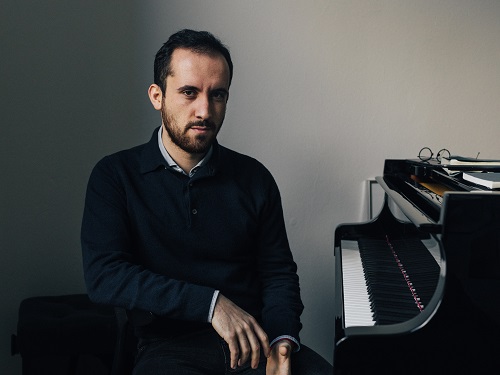 United Kingdom Bach: Igor Levit (piano), Wigmore Hall, London, 22.5.2019. (MB)
United Kingdom Bach: Igor Levit (piano), Wigmore Hall, London, 22.5.2019. (MB)

Bach – Goldberg Variations, BWV 988
With this outstanding performance of the Goldberg Variations, Igor Levit opened a series of three concerts performing celebrated sets of piano variations. To come are a pairing of Beethoven’s Diabelli Variations and Frederic Rzewski’s set on The People United Shall not be Defeated, and finally Ronald Stevenson’s Passacaglia on DSCH.
It struck me from the opening bars of the Aria that this would be a very different performance from that of Levit’s Sony recording. This was to be a performance for here and now, the work rethought and reimagined. Every note of the Aria seemed considered, quite without pedantry, instead freshly discovered: if not prelapsarian – Bach is too human for that – then pristine. This reading proved freer, I think, certainly different, and was very much a reading for the piano, sustained as only this instrument can. Pianists imitating harpsichordists seem to me as misguided as vice versa; they can and should learn from each other, but learning is a very different thing from an attempt to imitate that will always be in vain.
The first variation’s release of pent-up energy made for an ebullient contrast, variegated within a logical framework. (Is that not the essence of Bach?) Its two succeeding variations had a strong sense of succession, the third in particular already integrative of tendencies within the music we had heard up to the point. A pleasing sturdiness characterised the fourth, a sturdiness that yet quested – and how, leading to flawless virtuosity in the fifth: a brilliant moto perpetuo through which, crucially, music was realised. Harmonic twists told without exaggeration in the sixth, laying the groundwork for a finely pointed seventh variation that released Bach’s own caprice (as opposed to being capriciously realised). By the time that we reached the ninth variation, the third of the canons, a grace that elicited reflection – where we had been, would be, but also very much what lay beneath the surface – was, quite rightly, the order of the day. Intimations of a Mendelssohn scherzo in the eleventh, a twelfth variation that spoke of strong kinship with that sturdy fourth, and a thirteenth that presented Bach as inspiration for Mozartian classicism, left-hand voicing that was loved and elicited love, with a spring in its step: the dizzying conspectus of ways in which we might think of, perceive, and respond to variations could not have been more immanent. Energy once more released in the fourteenth invited Levit – invitation graciously accepted – to take all the time in the world for the fifteenth variation: an invitation, as Schumann might have put it, to explore new paths, technical and expressive.
And so, the ‘Ouverture’ sounded very much as such: a fierce, Frenchified exterior heralding just such new beginnings that were yet old. From the seventeenth variation onwards, there was very much a sense of new territory broached within that logical framework: for instance, a twentieth variation whose caprice connected us with the world of the seventh; a twenty-first that sounded both more archaic and more Romantic; and a twenty-second that proved beautifully, reassuringly reinventive, an utterance from the Bach whose well-nigh divine judgement brooks no appeal. Lisztian display in the twenty-third variation and Mozartian (perhaps Beethovenian too) response in its successor prepared the way for Wanda Landowska’s ‘black pearl’, taken slowly, as only a piano can. Composer and pianist alike offered a personal response of pathos that yet revelled in a labyrinthine harmonic imagination that looked towards Mozart’s re-imagings of Bach and Handel, even to Berg. This was a slow movement, an Adagio, in the emphatic sense.
Its successor, the twenty-sixth variation, might have sounded conventional by comparison – unless and until one listened. It really grew during its course, too, as did its successor in response; for by now, it was difficult not to think in Classical developmental terms as well as Bach’s own. The twenty-eight variation brought, even at this late stage, a true sense of ringing the changes, not least through Mozartian subtlety in the chromatic melodies of those crossed-hand lines. Heading towards apparent climax, the twenty-ninth variation was of course followed, surprisingly and unsurprisingly, by the rejoicing of the ‘Quodlibet’. It was a moment for taking stock, a time for Bach the Christian, non-exclusivist, synthetic, to remind us of the fathomless world of the church cantatas through good-natured, ‘domestic’ humour. (Beethoven would surely have nodded assent.) At least that was how it spoke to me: to others, it would doubtless have done differently. With the return to the Aria, we heard and felt something that was both the same as before and very much not. It was, rightly, unclear how and why: music, like so much else, is ultimately a mystery. There is no right and wrong, correct and incorrect: not, at any rate, in the way Thomas Beecham’s ‘drowsy armchair pedants’ would have it. Bach’s score had been beautifully, meaningfully brought to life; next time it would be different.
Mark Berry